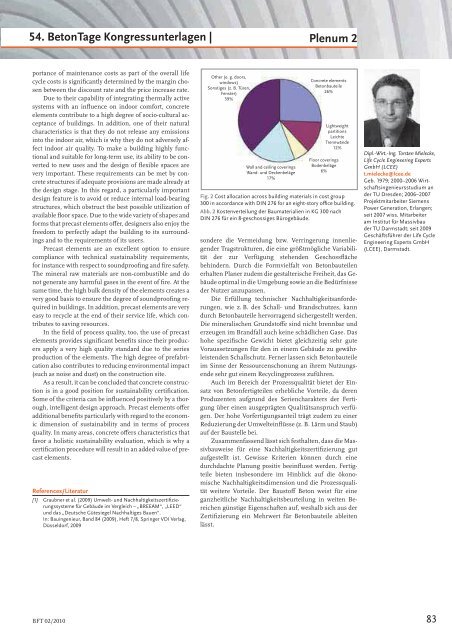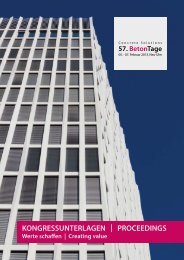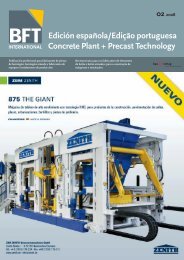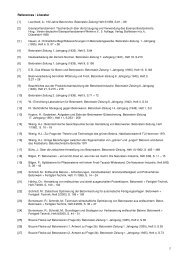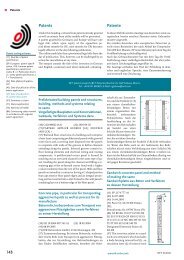Concrete Plant + Precast Technology Betonwerk ... - BFT International
Concrete Plant + Precast Technology Betonwerk ... - BFT International
Concrete Plant + Precast Technology Betonwerk ... - BFT International
Sie wollen auch ein ePaper? Erhöhen Sie die Reichweite Ihrer Titel.
YUMPU macht aus Druck-PDFs automatisch weboptimierte ePaper, die Google liebt.
54. BetonTage Kongressunterlagen |<br />
portance of maintenance costs as part of the overall life<br />
cycle costs is signifi cantly determined by the margin chosen<br />
between the discount rate and the price increase rate.<br />
Due to their capability of integrating thermally active<br />
systems with an infl uence on indoor comfort, concrete<br />
elements contribute to a high degree of socio-cultural acceptance<br />
of buildings. In addition, one of their natural<br />
characteristics is that they do not release any emissions<br />
into the indoor air, which is why they do not adversely affect<br />
indoor air quality. To make a building highly functional<br />
and suitable for long-term use, its ability to be converted<br />
to new uses and the design of fl exible spaces are<br />
very important. These requirements can be met by concrete<br />
structures if adequate provisions are made already at<br />
the design stage. In this regard, a particularly important<br />
design feature is to avoid or reduce internal load-bearing<br />
structures, which obstruct the best possible utilization of<br />
available fl oor space. Due to the wide variety of shapes and<br />
forms that precast elements off er, designers also enjoy the<br />
freedom to perfectly adapt the building to its surroundings<br />
and to the requirements of its users.<br />
<strong>Precast</strong> elements are an excellent option to ensure<br />
compliance with technical sustainability requirements,<br />
for instance with respect to soundproofi ng and fi re safety.<br />
The mineral raw materials are non-combustible and do<br />
not generate any harmful gases in the event of fi re. At the<br />
same time, the high bulk density of the elements creates a<br />
very good basis to ensure the degree of soundproofi ng required<br />
in buildings. In addition, precast elements are very<br />
easy to recycle at the end of their service life, which contributes<br />
to saving resources.<br />
In the fi eld of process quality, too, the use of precast<br />
elements provides signifi cant benefi ts since their producers<br />
apply a very high quality standard due to the series<br />
production of the elements. The high degree of prefabrication<br />
also contributes to reducing environmental impact<br />
(such as noise and dust) on the construction site.<br />
As a result, it can be concluded that concrete construction<br />
is in a good position for sustainability certifi cation.<br />
Some of the criteria can be infl uenced positively by a thorough,<br />
intelligent design approach. <strong>Precast</strong> elements off er<br />
additional benefi ts particularly with regard to the economic<br />
dimension of sustainability and in terms of process<br />
quality. In many areas, concrete off ers characteristics that<br />
favor a holistic sustainability evaluation, which is why a<br />
certifi cation procedure will result in an added value of precast<br />
elements.<br />
References/Literatur<br />
[1] Graubner et al. (2009) Umwelt- und Nachhaltigkeitszertifi zierungssysteme<br />
für Gebäude im Vergleich – „BREEAM“, „LEED“<br />
und das „Deutsche Gütesiegel Nachhaltiges Bauen“.<br />
In: Bauingenieur, Band 84 (2009), Heft 7/8, Springer VDI Verlag,<br />
Düsseldorf, 2009<br />
<strong>BFT</strong> 02/2010<br />
Other (e. g. doors,<br />
windows)<br />
Sonstiges (z. B. Türen,<br />
Fenster)<br />
39%<br />
Wall and ceiling coverings<br />
Wand- und Deckenbeläge<br />
17%<br />
Plenum 2<br />
<strong>Concrete</strong> elements<br />
Betonbauteile<br />
26%<br />
Lightweight<br />
partitions<br />
Leichte<br />
Trennwände<br />
12%<br />
Floor coverings<br />
Bodenbeläge<br />
6%<br />
Fig. 2 Cost allocation across building materials in cost group<br />
300 in accordance with DIN 276 for an eight-story offi ce building.<br />
Abb. 2 Kostenverteilung der Baumaterialien in KG 300 nach<br />
DIN 276 für ein 8-geschossiges Bürogebäude.<br />
sondere die Vermeidung bzw. Verringerung innenliegender<br />
Tragstrukturen, die eine größtmögliche Variabilität<br />
der zur Verfügung stehenden Geschossfl äche<br />
behindern. Durch die Formvielfalt von Betonbauteilen<br />
erhalten Planer zudem die gestalterische Freiheit, das Gebäude<br />
optimal in die Umgebung sowie an die Bedürfnisse<br />
der Nutzer anzupassen.<br />
Die Erfüllung technischer Nachhaltigkeitsanforderungen,<br />
wie z. B. des Schall- und Brandschutzes, kann<br />
durch Betonbauteile hervorragend sichergestellt werden.<br />
Die mineralischen Grundstoff e sind nicht brennbar und<br />
erzeugen im Brandfall auch keine schädlichen Gase. Das<br />
hohe spezifi sche Gewicht bietet gleichzeitig sehr gute<br />
Voraussetzungen für den in einem Gebäude zu gewährleistenden<br />
Schallschutz. Ferner lassen sich Betonbauteile<br />
im Sinne der Ressourcenschonung an ihrem Nutzungsende<br />
sehr gut einem Recyclingprozess zuführen.<br />
Auch im Bereich der Prozessqualität bietet der Einsatz<br />
von Betonfertigteilen erhebliche Vorteile, da deren<br />
Produzenten aufgrund des Seriencharakters der Fertigung<br />
über einen ausgeprägten Qualitätsanspruch verfügen.<br />
Der hohe Vorfertigungsanteil trägt zudem zu einer<br />
Reduzierung der Umwelteinfl üsse (z. B. Lärm und Staub)<br />
auf der Baustelle bei.<br />
Zusammenfassend lässt sich festhalten, dass die Massivbauweise<br />
für eine Nachhaltigkeitszertifi zierung gut<br />
aufgestellt ist. Gewisse Kriterien können durch eine<br />
durchdachte Planung positiv beeinfl usst werden. Fertigteile<br />
bieten insbesondere im Hinblick auf die ökonomische<br />
Nachhaltigkeitsdimension und die Prozessqualität<br />
weitere Vorteile. Der Baustoff Beton weist für eine<br />
ganzheitliche Nachhaltigkeitsbeurteilung in weiten Bereichen<br />
günstige Eigenschaften auf, weshalb sich aus der<br />
Zertifi zierung ein Mehrwert für Betonbauteile ableiten<br />
lässt.<br />
Dipl.-Wirt.-Ing. Torsten Mielecke,<br />
Life Cycle Engineering Experts<br />
GmbH (LCEE)<br />
t.mielecke@lcee.de<br />
Geb. 1979; 2000–2006 Wirtschaftsingenieursstudium<br />
an<br />
der TU Dresden; 2006–2007<br />
Projektmitarbeiter Siemens<br />
Power Generation, Erlangen;<br />
seit 2007 wiss. Mitarbeiter<br />
am Institut für Massivbau<br />
der TU Darmstadt; seit 2009<br />
Geschäftsführer der Life Cycle<br />
Engineering Experts GmbH<br />
(LCEE), Darmstadt.<br />
83


